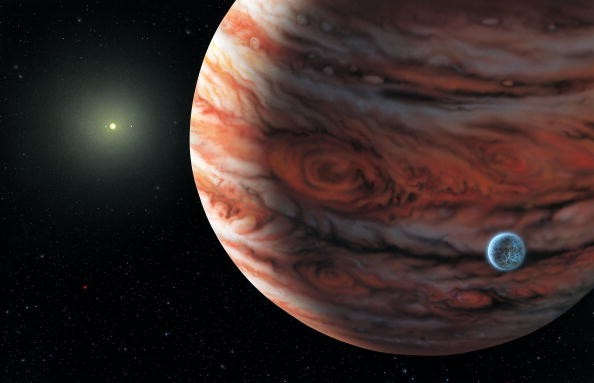Solar System 2.0? Jupiter's Twin Detected Orbiting a Star Similar to Our Own Sun
| Ana Verayo | | Jul 16, 2015 06:00 AM EDT |
(Photo : Getty Images/Handout) An artist’s impression showing a newly discovered Jupiter twin gas giant orbiting the solar twin star, HIP 11915. The planet is of a very similar mass to Jupiter and orbits at the same distance from its star as Jupiter does from the Sun.
Astronomers have recently detected an exoplanet that could pass off as Jupiter's twin called HIP 11915b, which is also a massive alien world that is observed to orbit around its parent star.
Scientists are in the quest to find another "super Earth" including twin counterparts of the rest of the planets in the solar system since they believe that during one point in time in the universe, many planets including stellar systems were almost identical to our own.
Like Us on Facebook
Since more than 1,000 exoplanets have been discovered, astronomers have also made new discoveries about different types of solar systems. According to Jorge Melendez of the Universidade de São Paulo, the search for Earth 2.0 and a complete Solar System 2.0 is probably one of the most exciting astronomical endeavors. Thanks to the ESO's (European Organisation for Astronomical Research in the Southern Hemisphere) observational facilities, the team was able to carry out this cutting edge research, according to CNet.
The European Southern Observatory houses a 142-inch powerful telescope to observe distant star systems including one star that is very similar to our own sun. Using a scientific instrument called High Accuracy Radial Velocity Planet Searcher, the astronomers made a detection of a planet similar to the colossal gas giant in our own solar system, Jupiter, according to Discovery News.
This massive exoplanet however, is not just almost the same size as Jupiter but it is also orbiting within the same distance from its parent star as Earth to the sun. Scientists also predict that this exoplanet alien twin world may also have a similar composition to Jupiter.
The exoplanet's parent star, HIP 11915, is also oddly similar to our own sun which can also be considered as sun's twin version, reveals RedOrbit. Astronomers confirm that the mass of the star is almost the same of the sun, including its size and composition.
For scientists, the exoplanets that are the easiest to detect are massive worlds that are in close orbit with their parent star. Bigger planets make these detections easier since they can block a significant amount of light from their sun during transit where they can be picked up by space telescopes and ground observatories alike.
Searching for alien life within these alien planets could prove almost impossible since scientists believe that they are highly inhospitable places to live in due to extreme weather conditions. Apart from this, astronomers also believe that the HIP 11915 system could also contain smaller worlds.
According to Megan Bedell from the University of Chicago, after 20 years of hunting for exoplanets, gas giant planets are slowly emerging into existence that are strikingly similar to our own solar system, courtesy of advanced technology such as the HARPS instrument. This new study is published in the journal Astronomy & Astrophysics.
Tagsjupiter twin, Jupiter, Exoplanets, ESO, jupiter similar identical sun exoplanet, Solar System 2.0? Jupiter's Twin Detected Orbiting a Star Similar to Our Own Sun
©2015 Chinatopix All rights reserved. Do not reproduce without permission
EDITOR'S PICKS
-

Did the Trump administration just announce plans for a trade war with ‘hostile’ China and Russia?
-

US Senate passes Taiwan travel bill slammed by China
-

As Yan Sihong’s family grieves, here are other Chinese students who went missing abroad. Some have never been found
-

Beijing blasts Western critics who ‘smear China’ with the term sharp power
-

China Envoy Seeks to Defuse Tensions With U.S. as a Trade War Brews
-

Singapore's Deputy PM Provides Bitcoin Vote of Confidence Amid China's Blanket Bans
-

China warns investors over risks in overseas virtual currency trading
-

Chinese government most trustworthy: survey
-

Kashima Antlers On Course For Back-To-Back Titles
MOST POPULAR
LATEST NEWS
Zhou Yongkang: China's Former Security Chief Sentenced to Life in Prison

China's former Chief of the Ministry of Public Security, Zhou Yongkang, has been given a life sentence after he was found guilty of abusing his office, bribery and deliberately ... Full Article
TRENDING STORY

China Pork Prices Expected to Stabilize As The Supplies Recover

Elephone P9000 Smartphone is now on Sale on Amazon India

There's a Big Chance Cliffhangers Won't Still Be Resolved When Grey's Anatomy Season 13 Returns

Supreme Court Ruled on Samsung vs Apple Dispute for Patent Infringement

Microsoft Surface Pro 5 Rumors and Release Date: What is the Latest?










